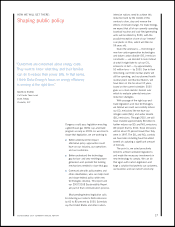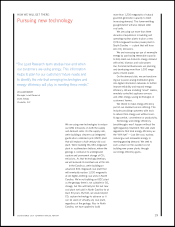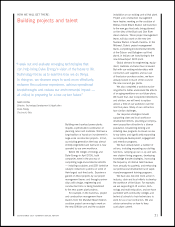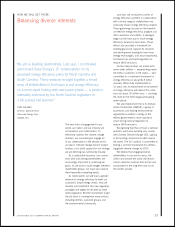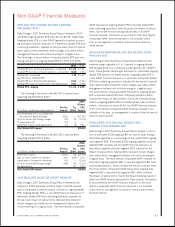Duke Energy 2007 Annual Report Download - page 25
Download and view the complete annual report
Please find page 25 of the 2007 Duke Energy annual report below. You can navigate through the pages in the report by either clicking on the pages listed below, or by using the keyword search tool below to find specific information within the annual report.
DUKE ENERGY 2007 SUMMARY ANNUAL REPORT 23
“My job is building relationships. Last year, I coordinated
and hosted Duke Energy’s 15 ‘collaboratives’ on its
proposed energy efficiency plans for North Carolina and
South Carolina. These sessions brought together a broad
array of stakeholders to find ways to put energy efficiency
on a more equal footing with new power plants — a position
ultimately endorsed by the North Carolina legislature in
a bill passed last summer.”
CARL WILKINS
Director, Utility Services
Advanced Energy Corp.
Raleigh, N.C.
The new rules of engagement in our
world, our nation and our industry are
conversation and collaboration. To
effectively address the climate change
problem, we are working to engage all
of our stakeholders in the debate and in
our plans. Climate change doesn’t respect
borders, so to build support for our strategy
we are defining our community broadly.
As a sustainable business, our connec-
tions with and among stakeholders are
increasingly important to achieving our
goals. As we work to build bridges between
stakeholder groups, we must also balance
their frequently competing needs.
As noted earlier, we will have a greater
reliance on energy efficiency to meet our
customers’ future energy needs. How we
develop and implement this new regulatory
paradigm will largely be decided by state
utility regulators. But the momentum to get
the job done is coming from many sectors,
including utilities, customer groups and
the environmental community.
Last year, we conducted a series of
energy efficiency summits in collaboration
with a broad range of stakeholders and
nationally known energy efficiency experts.
These gatherings focused on the benefits
an effective energy efficiency program can
offer customers and utilities. A dialogue
began on the best way to move energy
efficiency forward in each state. These
efforts also provided a framework for
building grassroots support for research
and development funding for new clean
energy technologies, and most importantly,
for federal cap-and-trade legislation to
reduce GHG emissions.
On the national level, we joined with
seven other utilities — representing nearly
20 million customers in 22 states — who
committed to a combined investment in
energy efficiency of about $1.5 billion
annually. When fully implemented in
10 years, this increased level of investment
in energy efficiency will reduce CO2 emis-
sions by about 30 million tons — avoiding
the need for 50 500-megawatt peaking
power plants.
We also helped form the U.S. Climate
Action Partnership (USCAP), a group of
businesses and leading environmental
organizations united in calling on the
federal government to move quickly to
enact strong national legislation to
reduce GHG emissions.
Recognizing that this isn’t just a national
problem, we’re also working very closely
with Combat Climate Change (3C), a group
of 46 leading companies located around
the world. The 3C coalition is committed to
finding a common framework for address-
ing global climate change by 2013.
We believe that engaging diverse
stakeholders in our service areas, the
nation and around the world will lead to
carbon reduction policies that are fair and
sustainable for the long term and for all
the world’s people.
HOW WE WILL GET THERE:
Balancing diverse interests






